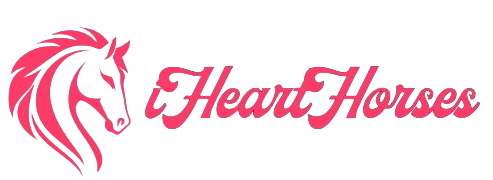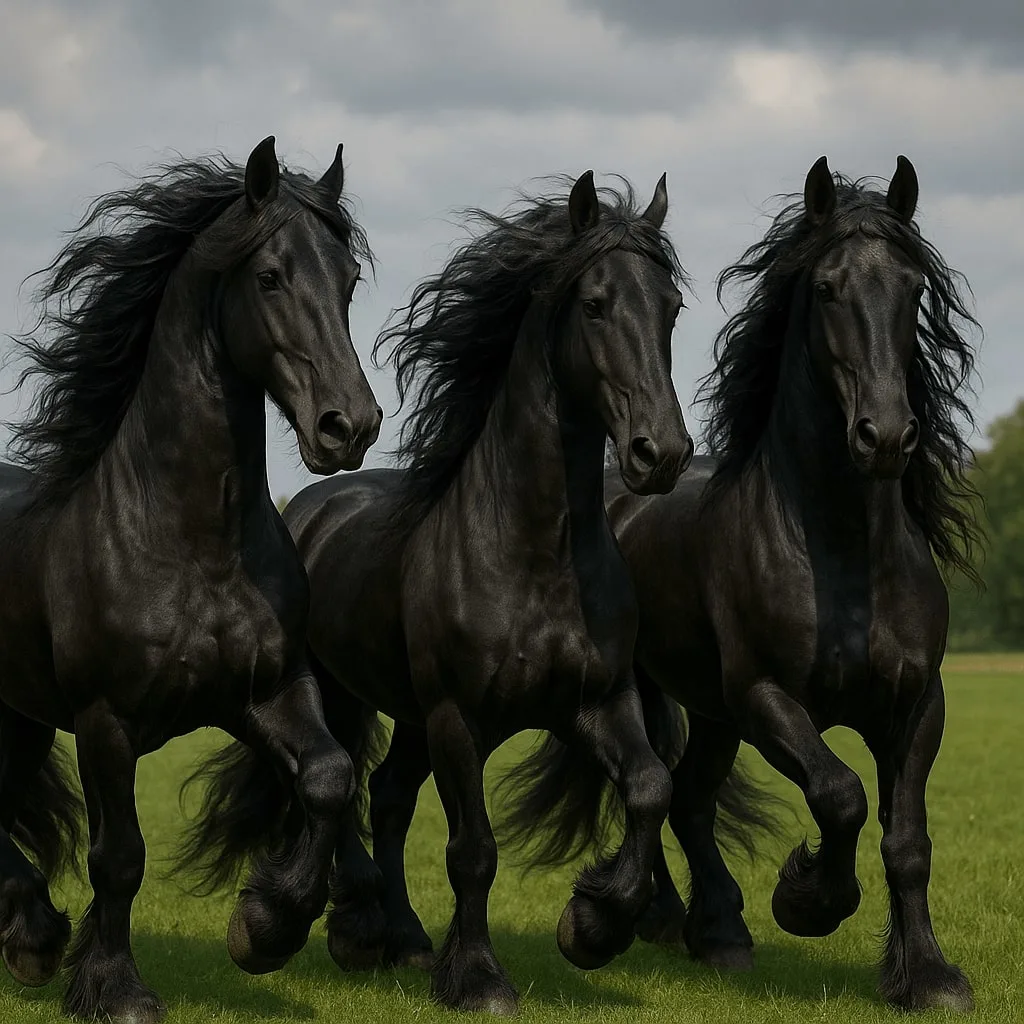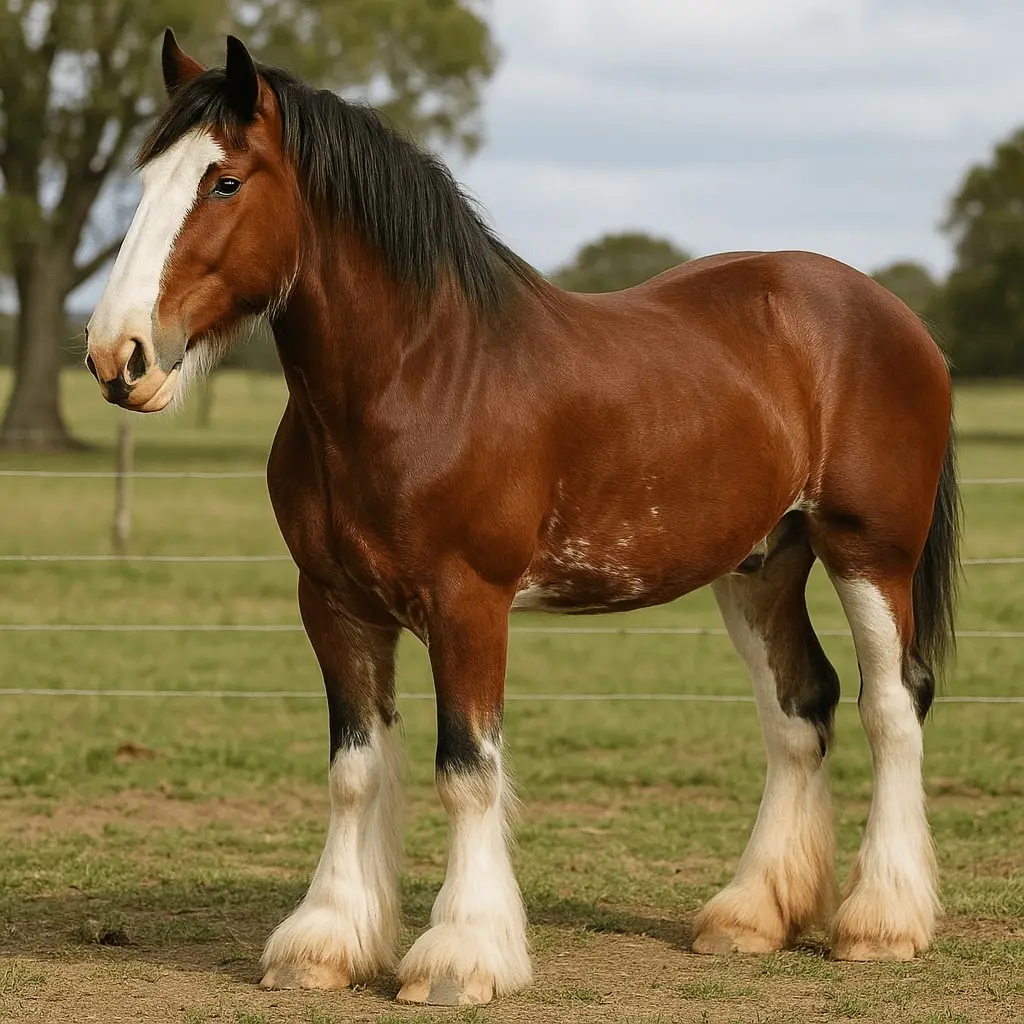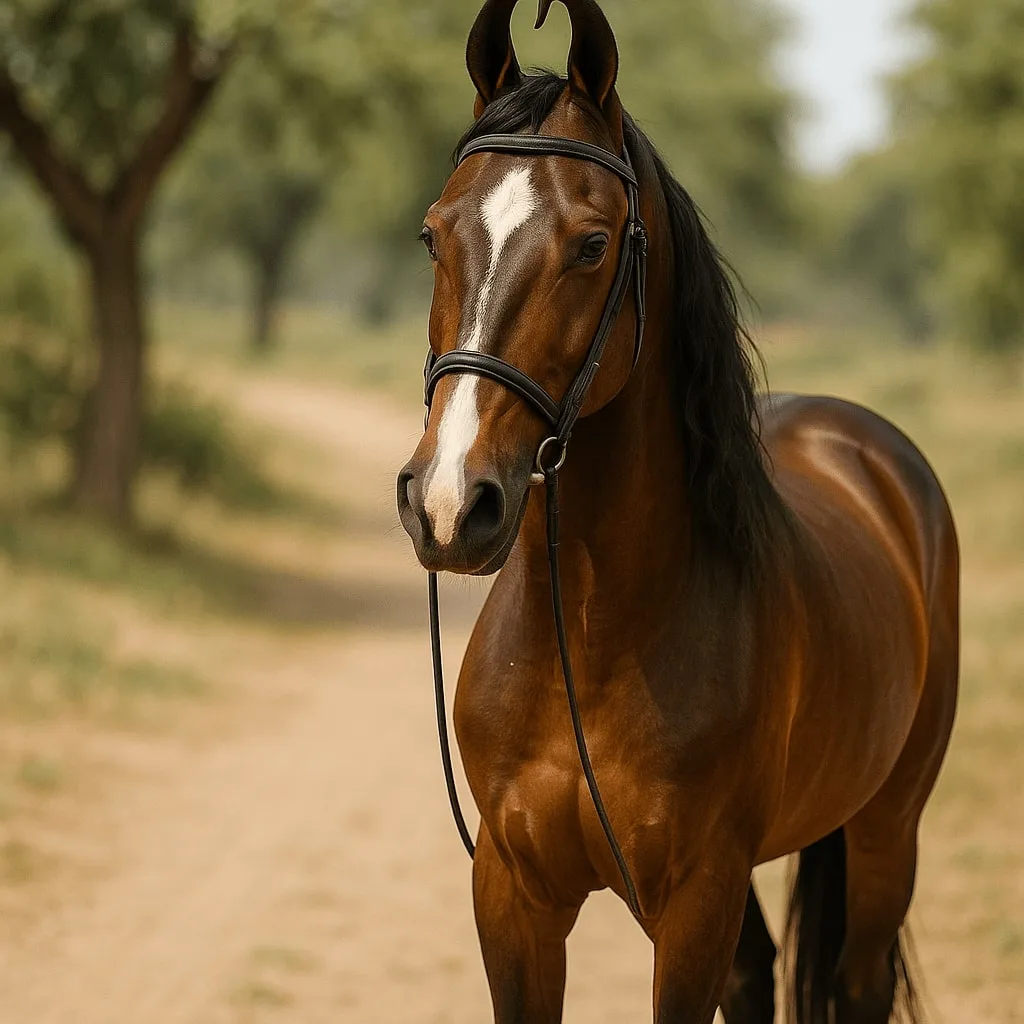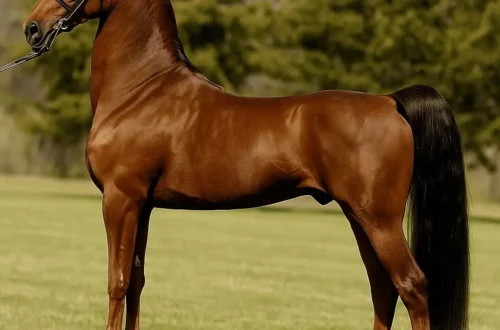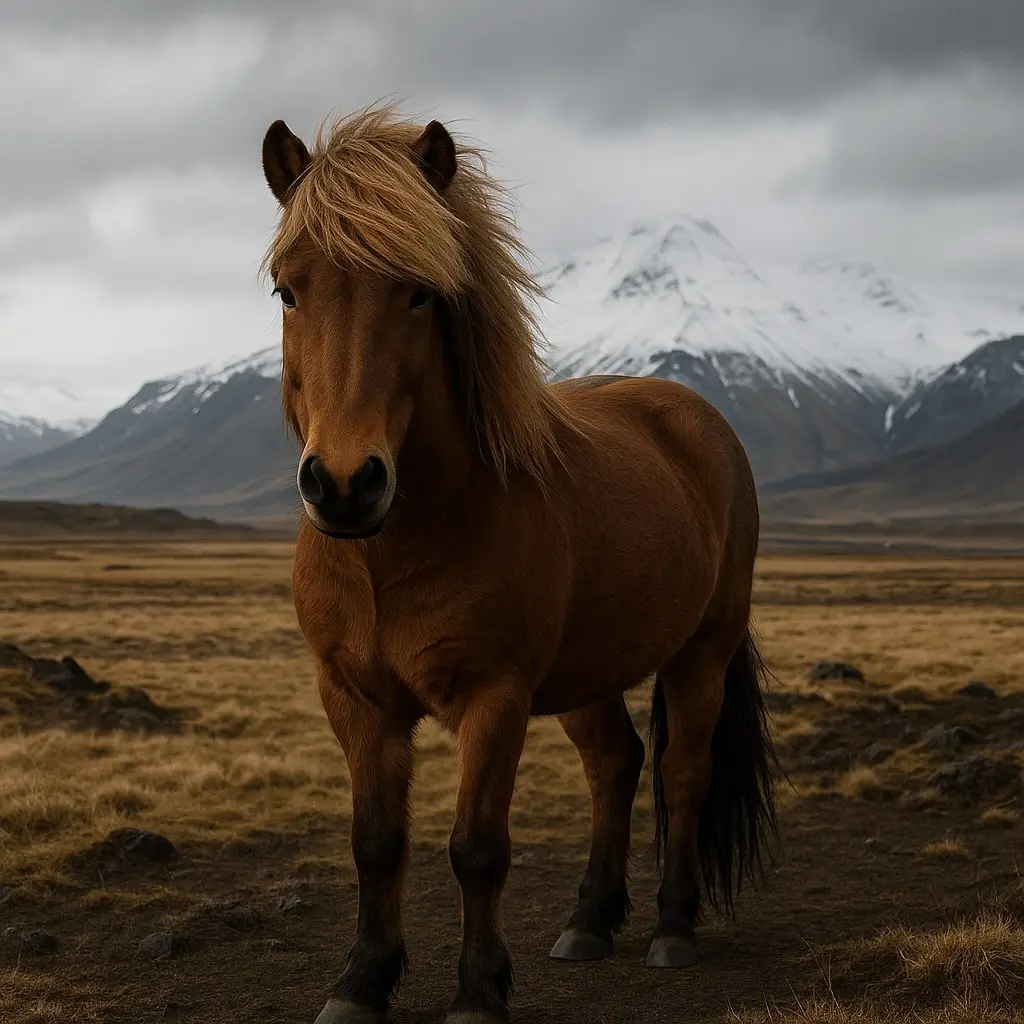Nestled in the wetlands of Friesland in the northern Netherlands, the Friesian horse feels like a creature from legends. It has a deep black coat, a long flowing mane and tail, and silky hair around its feet. People have loved this breed for hundreds of years because of its beauty.
The Friesian is built like a light draft horse or a baroque warmblood. It is strong and muscular, but it moves with grace. Its high-stepping trot makes it look powerful and elegant. This breed truly stands out in both strength and beauty.
This blog shares many interesting fun facts about Friesian horses. It covers their long history, special traits, gentle behavior, and many roles. You will also learn how they appear in movies and what health issues they may face.
Whether you are a breeder, a fan, or just curious about these horses, this blog is for you. Prepare to fall in love with the elegant and powerful Friesian horse, one of the best royal horse breeds.
Why are Friesians rare?
The first most common fact about the Friesians is that they are RARE! This fact also raises a question among the horse-loving community. Whyyy? Why are Friesians rare? So, here is a detailed answer for them. Though if you find the answer incomplete or it doesn’t quench your query, feel free to ask for a complete blog based on revealing what’s behind their rarity.
1. Historical Bottleneck
- By the early 1900s, Friesian horses were almost extinct. By 1913, only three purebred stallions remained in Friesland, along with a few mares. This very small group became the genetic base for all modern Friesian horses..
- Although the breed grew again with help from a studbook and royal supporters, the number of Friesians stayed low. The studbook began in 1879 to register and protect pure Friesians. Even with that, the horses remained mostly bred within a small community. Because breeding stayed so limited, the Friesian breed stayed rare. Their gene pool stayed small. This isolation helped maintain their unique traits, but also kept the breed uncommon.
2. Strict Registration Rules
- The Koninklijke Friesch Paarden-Stamboek (KFPS) sets very strict rules for registering Friesian horses:
- Only solid black horses are allowed. Some black-bay shades are okay, but horses must have no white marks except possibly a small star on the forehead. Any other marking disqualifies the horse from registration.
- Stallions must pass a DNA test to prove they do not carry the chestnut gene. Horses with that gene cannot enter the breeding studbook.
- To qualify, horses must meet minimum height standards: mares and geldings must be at least 15.2 hands (about 62 inches), and stallions at least 15.3 hands (1.60 m). They also must have top-notch body structure and movement quality.
- As a result, only 20 to 30% of foals earn “Star” status when they are presented as adults for inspection. Star status means they meet high standards for conformation, movement, and height. Very few stallions gain full breeding approval. They must pass many tests. Only the top-quality stallions can become approved breeders.
3. Small Gene Pool & Inbreeding
- The Friesian horse breed started with only a few horses long ago. This small beginning led to years of inbreeding (breeding closely related horses). Sadly, this makes certain genetic health problems more common in Friesians. These include:
- Dwarfism (very small size)
- Hydrocephalus (fluid buildup in the brain)
- Megaesophagus (an enlarged food pipe)
- Aortic rupture (a tear in the heart’s main blood vessel)
- Today, Friesian horse breeding is carefully controlled. However, inbreeding still happens at about 0.5% each new generation. This rate is under the limit set by the UN’s food organization (FAO). But it shows the breed’s gene pool is very small. This means there are too few different genes in the population.
4. Friesian Health Risks: Limit Breeding Stock
Friesian horses face several serious health problems:
- Dwarfism: About 1 in 400 Friesians are born very small (dwarfism).
- Hydrocephalus: Foals born with “water on the brain” (hydrocephalus) often die.
- Birthing Trouble: More than half of Friesian mares need a vet’s help after giving birth to deliver the placenta (afterbirth).
- Skin & Immunity: They often get skin infections under their long leg hair (“feathers”) and tend to get sick more easily overall.
These health problems mean fewer Friesian horses are healthy enough to breed. This makes it hard to grow the breed’s population safely.
5. Limited Numbers Worldwide
- Worldwide, there are about 70,000 to 80,000 registered purebred Friesian horses. Of these:
- Only 8,000–10,000 live in the United States.
- About 12,000 are registered just in the Netherlands (where the breed began).
Friesian horses are rare today for several reasons. Long ago, they almost went extinct. Today, strict rules about how they must look and move mean only a few can be used for breeding. They also have a very small gene pool, which causes health problems. Plus, there just aren’t many worldwide – only about 70,000 to 80,000 exist. This rarity is partly on purpose. Breeders work hard to keep the Friesians’ pure bloodline and special traits, like their shiny black coats and feathered legs. Sadly, this focus on purity makes it much harder to increase their numbers.
Fun Facts About Friesian Horses Wikipedia
Here are a few fun facts about Friesian Horses. These facts are purely based on history, their appearance, temperament, and much more, you would love to explore!
Friesian Historical Facts
Friesian Ancient Roots:
The Friesian horse comes from Friesland in the northern Netherlands. It’s the only horse breed native to the country. Records from Roman times (4th century) mention Friesian soldiers on horseback. Art from the 11th to 13th centuries shows horses that look like Friesians carrying knights in battle.
Medieval Warhorse:
For centuries, Friesians were valued warhorses. They were strong, almost always black, and stood about 5 feet tall at the shoulder. They were more agile than other heavy warhorses. During the 1500s and 1600s (when Spain ruled the Netherlands), they were mixed with Spanish Andalusian horses. This created a lighter, elegant horse good for pulling carriages, but they still looked like Friesians.
Friesian Farm & Racing Era:
By the 1700s and 1800s, Friesians worked on farms, pulled carriages, and became popular in fast trotting races. In the late 1800s, some breeders tried to make them lighter for racing. However, others pushed to keep the original, heavier type pure.
Friesian Near Extinction & First Studbook:
By 1879, Friesian numbers were very low. Farmers started the first official Friesian Horse Studbook to save them. Sadly, crossbreeding with bigger “Bovenlander” horses and the rise of farm tractors almost wiped out pure Friesians. Amazingly, by 1900, only three purebred Friesian stallions were left.
Friesian Modern Recovery:
Dedicated breeders later added a little Oldenburg horse blood and formed groups like “Het Friesch Paard” to rescue the breed. World War II was tough, but after the war, Friesians became stars in traveling circuses (like Circus Strassburger). This showed them to people outside Friesland, creating new fans and helping their numbers finally grow again.
Friesian Appearance and Breed Standards
Friesian Color & Coat:
Friesian horses are famous for their solid black coats and long, flowing manes and tails. They have special “feathers” – thick, wavy hair around their lower legs. Breed rules are very strict:
- Only a tiny white star on the forehead is allowed.
- Any horse carrying the red (chestnut) gene cannot be a registered purebred stallion. (All stallions are DNA tested to make sure they don’t have this gene.)
Friesian Body & Build:
Friesians have a strong, powerful body with a gracefully arched neck held high. They carry their head proudly with short, alert ears and expressive eyes. Their legs are short, sturdy, and covered in feathers down to the ankles. Their most famous move is a lively, high-stepping trot that looks both elegant and powerful.
There are two main types:
- Baroque Friesian: The classic look – heavier, stronger body.
- Sport Friesian: More modern – lighter body and finer bones.
Both types share the key Friesian features: jet-black color, long feathers, high knee action, and flowing mane/tail. The Sport type is more popular in competitions today.
Friesian Size:
Most Friesians stand between 15 and 17 hands high (5 to 5.6 feet tall at the shoulder) and weigh 1,200 to 1,400 pounds. To get the highest pedigree status, mares and geldings must be at least 15.2 hands (about 5 ft 2 in) tall when fully grown. The average adult Friesian is around 15.3 hands.
Friesian Breed Standards:
The long mane, tail, and leg feathers are almost never cut – it’s part of their majestic look. The official registry has strict rules about color:
- Sun-bleached coats (lighter black) are okay.
- White markings bigger than a small star are not allowed.
- Chestnut-colored Friesians are penalized or barred from registration.
Friesian Temperament and Behavior
Gentle & Calm Nature:
Friesians are famous for being gentle, calm, and steady-tempered. They have energy but rarely get overly excited or spooked. This makes them reliable partners for riding in busy areas, parades, or on trails. Many owners call them “gentle giants” because of their quiet confidence.
Smart & Willing to Learn:
These horses are highly intelligent and quick learners, making them one of the most intelligent horse breeds. They pick up new skills fast – whether it’s dressage moves, movie tricks, or simple commands. Friesians want to please their handlers, so they patiently repeat drills or follow complex cues without getting bored or frustrated. This makes them one of the easiest breeds to train.
Unshakably Brave:
A Friesian’s cool head is legendary. Loud noises, crowds, flashing lights – they take it all in stride. This fearlessness is why they’re trusted on film sets, city tours, and festivals. While other horses might panic, a Friesian stays focused and calm.
People-Oriented & Patient:
Friesians bond deeply with their owners and enjoy human company. They’re famously tolerant, making them safe for riders of all levels – even beginners. Whether learning a new trick or carrying a child, they respond willingly to anyone who treats them kindly.
Friesian Uses and Disciplines
Historical Warhorse (Medieval – 1600s):
Friesians carried armored knights into battle for centuries. Their strength, stamina, and bravery made them trusted warhorses. This heroic past is why they’re often cast in fantasy movies today!
Farm & Draft Work (1700s – 1940s):
Before tractors, Friesians plowed fields, pulled heavy wagons, and worked on dairy farms. They were lighter than most draft breeds but equally willing. Sadly, farm machinery replaced them after WWII.
Riding & Dressage (Modern):
Today, Friesians are beloved riding horses. Their elegance and “uphill” trot make them dressage stars, while their calmness suits trail riding. Riders love their steady nerves in busy arenas.
Carriage Driving (Traditional & Modern):
Friesians are famous carriage horses. They traditionally pulled Dutch sjees carts and now star in driving competitions worldwide. Their strength + calm endurance are perfect for parades or long tours.
Ceremonial & Show Roles (1800s – Present):
With their majestic looks and poise, Friesians are natural performers:
- Pulled 700+ funeral hearses in Victorian London
- Lead parades and royal pageants
- Perform in circuses (thanks to their trainability)
- Appear in movies/TV as “knights’ horses”
Friesian Health Secrets: Genetic Risks & Lifespan
Friesian Inherited Disorders:
Due to limited genes, Friesians face several hereditary health issues:
- Dwarfism: Very short legs (affects ~1 in 400 foals).
- Hydrocephalus: “Water on the brain” (often fatal in newborns).
- Aortic Rupture: A Tear in the heart’s main artery.
- Megaesophagus: Enlarged food pipe causing choking.
- PSSM: A common muscle disease in draft breeds, causing stiffness.
Friesian Genetic Testing:
Breeders use DNA tests to:
- Avoid breeding horses carrying dwarfism/hydrocephalus genes.
- Ensure stallions lack the chestnut (“red”) gene (keeps coats black).
- This careful breeding helps reduce disease risks.
Friesian Common Health Problems:
- Leg Feather Issues: Long hair traps moisture → skin infections (“scratches”).
- Insect Allergies: Intense itching from bites.
- Weaker Immunity: More prone to infections.
- Digestive Sensitivity: Higher risk of colic/stomach upsets.
Friesian Reproductive Challenge:
- 54% of Friesian mares need vet help after birth to pass the placenta.
- This rate is far higher than most breeds due to genetics.
Friesian Lifespan & Size:
Average Lifespan: 15–17 years (shorter than many horse breeds).
- Typical Weight: 1,200–1,400 lbs (like most other breeds).
- Genetic weaknesses likely contribute to their shorter lives.
Friesians in Pop Culture and Entertainment
Lights, Camera, Action!
Friesians steal the show in fantasy and history films with their jet-black coats and dramatic high steps. Famous appearances include:
- Ladyhawke (1985): Stallion “Othello” played by Rutger Hauer’s horse, making Friesians famous in America.
- Blockbusters like *300*, Narnia, Hunger Games, and Zorro.
- Countless period dramas needing majestic “knight horses.”
Television & Streaming Stars
Friesians light up screens big and small:
- Bridgerton (Netflix): A Friesian named Jack carried lead actor Jonathan Bailey.
- Free Rein (BBC/Netflix): A Friesian-cross horse named Raven co-stars.
- Game of Thrones and other shows needing eye-catching horses.
Live Performances & Parades
Beyond screens, Friesians dazzle live audiences:
- Circus stars (like Europe’s Circus Strassburger) thanks to trainability.
- Parade royalty with their calm nerves in crowds.
- Ceremonial carriage horses for weddings/events.
- Trick-riding partners due to agility and flair.
Unique and Surprising Friesian Facts
Victorian Funeral Horses
In Victorian London, Friesians were the funeral horse. At their peak, around 700 jet-black Friesians pulled hearses and carriages in grand processions. Their dignified presence made them the top choice for solemn events.
Friesian Breeding Legacy
Friesian blood helped create other famous breeds:
- Shire Horses: England’s gentle giants got stronger with Friesian genes.
- Morgan Horses: America’s beloved all-rounders share Friesian roots.
In short, Friesians helped build these breeds!
The “White Friesian” Myth
Purebred Friesians are always born black. A famous “white” Friesian (actually 75% Friesian, 25% Arabian) once turned heads, but true white Friesians don’t exist.
Friesian Grooming Demands
That iconic flowing mane, tail, and leg feathers need daily care:
- Brush feathers to prevent skin infections.
- Braid manes/tails to manage tangles.
- Check legs for moisture or dirt buildup.
Tip: Grooming is bonding time!
Friesian Name Spelling
In older English texts, you might see “Frizian.” Their Dutch names are Fries Paard or Frysk Hynder.
Friesian Population Today
Friesians are no longer near extinction:
- 40,000+ registered worldwide (early 2000s).
- 7% of all Dutch horses are Friesians (~1 in 14!).
Their majestic looks and gentle nature keep the breed thriving.
Fun Facts About Friesian Horses For Kids
For beginners or kids who wonder What are 10 interesting facts about horses for kids? This section is specially for you guys. Enjoy!
What Are Friesian Horses Used For
Performing Dressage
Their powerful trot, natural “uphill” movement, and grace make them dressage stars – from training arenas to Olympic-level competitions.
Pulling Carriages
Friesians are world-famous driving horses. They traditionally pull Dutch sjees carts and shine in parades, competitions, and scenic tours thanks to their strength + calmness.
Riding & Recreation
Gentle enough for beginners yet athletic for experts, they’re beloved trail, lesson, and show horses. Their steady nerves handle busy arenas and unpredictable trails.
Making Movie Magic
With jet-black coats and dramatic movement, they’re the #1 choice for fantasy films (Narnia, Game of Thrones) and historical epics – looking like real-life storybook steeds.
Honoring History
- Medieval: Carried armored knights into battle.
- 1700s–1940s: Plowed fields and hauled wagons.
- Victorian Era: Over 700 pulled funeral carriages in London alone.
Famous Friesian Horses
Frederik the Great
This jet-black stallion became a social media sensation with thousands of fans! Known for his breathtaking beauty and flawless carriage performances, he’s one of the most famous Friesians alive.
Black Sterling
A West Coast (USA) legend, this stallion dominated horse shows for over 10 years. He won countless English Pleasure and Under-Saddle titles before passing away in 2014.
Othello (Goliath)
The original Hollywood Friesian! He starred as Rutger Hauer’s warhorse in Ladyhawke (1985). His role ignited America’s love for the breed.
Ariaan & Tonka
These two stallions shared the role of “Tornado” in The Mask of Zorro (2005). Producers chose them for their perfect size and majestic black coats.
Friesian Horse Height in Feet
Friesian Typical Range:
- 14.2 to 17 hands
*(4’10” to 5’8″ / 1.47m to 1.73m at the shoulder)*
Average Friesian Adult Height:
- 15.2–15.3 hands
*(5’0″ to 5’3″ / 1.57m to 1.60m)
Friesian Pedigree Requirements:
To earn top breeding/status papers:
- Mares & Geldings: Must be ≥ 15.2 hands (5’0″ / 1.57m).
- Stallions: Must be ≥ 15.3 hands (5’3″ / 1.60m).
Note: 1 hand = *(4 inches / 10 cm)*
White Friesian Horse – The Myth
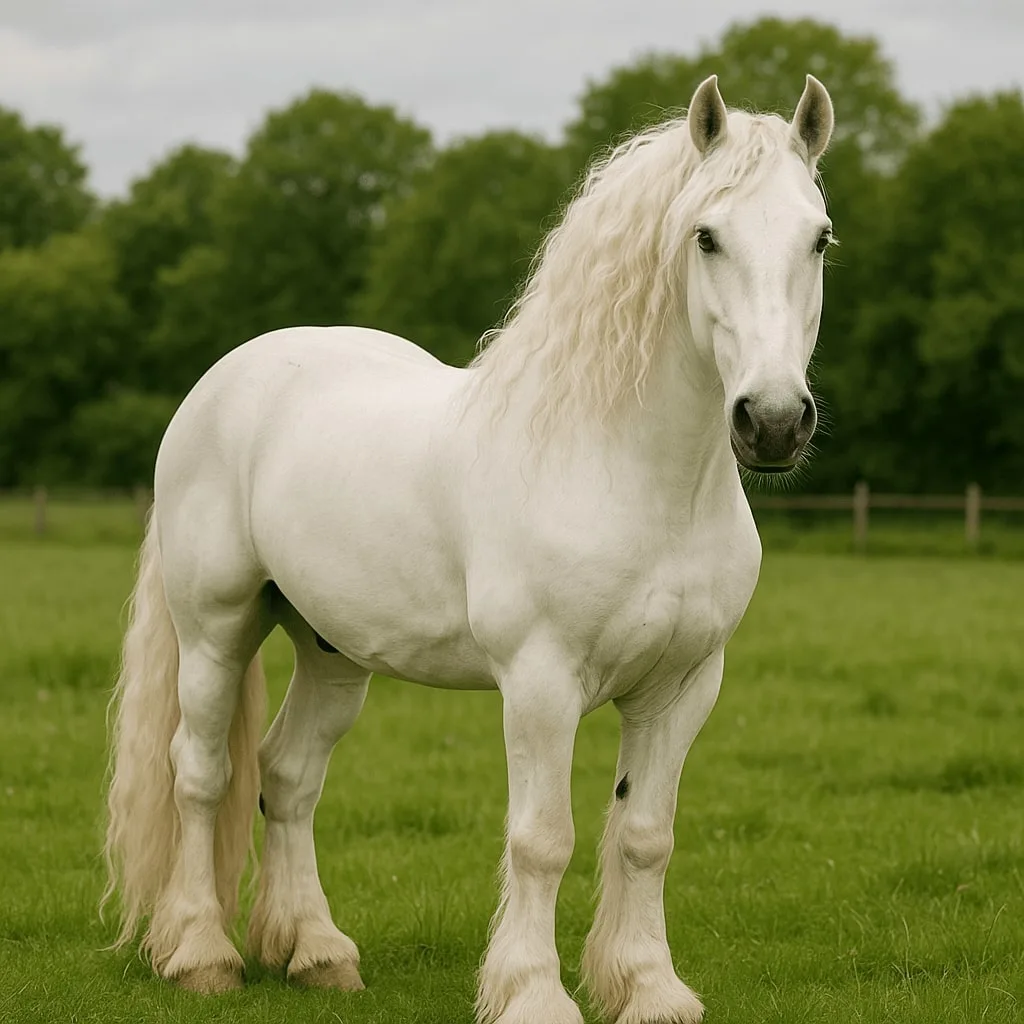
Purebred Friesians are always black.
No registered purebred Friesian has ever been born white. Their genes only allow black coats (sometimes sun-bleached to brown). Any “white Friesian” is either:
- A mixed-breed horse (e.g., Friesian x Arabian)
- A different breed entirely mislabeled as Friesian
Why the Confusion?
- Stock Photos: Many photo sites wrongly tag elegant white horses as “Friesians” for clicks.
- Social Media: Viral posts of rare crossbreeds (like the part-Arabian “chartreuse Friesian”) spread myths.
- Movies/TV: Production companies may use white horses costumed as Friesians.
Key Takeaway:
True Friesians have solid black coats – it’s a core breed requirement. White examples are either crossbreds or misidentified horses.
Friesian Horse Color Facts
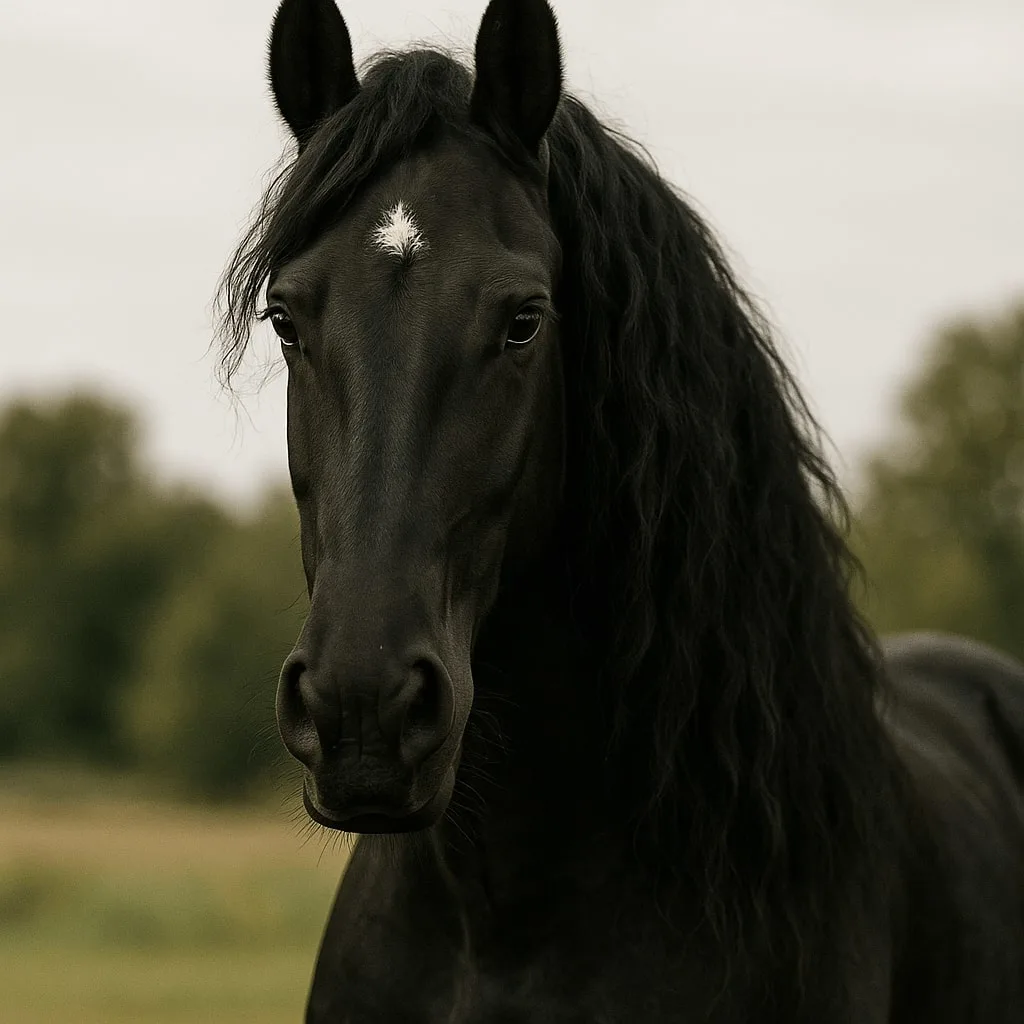
- Purebred Friesian horses are always solid black, with just one small exception: a star on the forehead no larger than a coin is permitted. Any other white markings (like socks, blazes, or spots) disqualify a horse from purebred status.
- While rare, chestnut coloring can appear if hidden recessive genes surface but stallions carrying the chestnut gene are banned from breeding registries (confirmed via DNA testing).
- Natural sun-bleaching that turns the coat brownish or “rusty” is fully tolerated, as are dapples (“dimpling”), since these don’t affect the horse’s genetic black base. In short: if it’s a registered Friesian, it’s born black and remains fundamentally black for life.**
Fun Facts About Friesian Horses – In A Nutshell
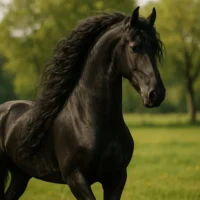
We’ll now wrap up this blog “fun facts about Friesian Horses” by saying out loud that The Friesian Horse Is A Living Legend, ancient, strikingly beautiful, and incredibly versatile. Once nearly lost to history with just three purebred stallions left in the 1900s this majestic breed survived thanks to dedicated breeders, wartime resilience, and a worldwide love for its noble presence.
Today, Friesians dazzle us everywhere: dancing in dressage rings, starring in films, pulling royal carriages, and winning hearts with their jet-black coats, flowing manes, and calm personalities. While breeders work hard to protect them from genetic health issues, the Friesian stands stronger than ever as a symbol not just of historic grandeur, but of courage and grace.
Whether you admire their regal looks, trainable minds, or brave spirit, these horses offer a rare blend of beauty, brains, and heart. As their caretakers and admirers, we’re honored to preserve the legacy of Friesland’s feathered black treasure, celebrating every graceful step they take into the future.
